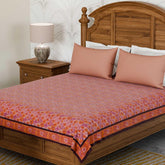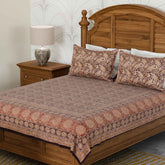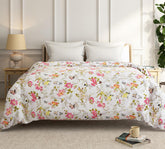Cotton vs Cotton Blend: Which Fabric Should You Choose?

Whenever you shop for a t-shirt, a bedsheet, or a table runner, the first thing you probably check is: What’s it made of? That’s because comfort, durability, and ease of use all depend on the quality of the fabric.
When it comes to fabric, two of the most common fabric types you’ll come across are pure cotton and cotton blend. While they sound similar, their properties and ideal uses are quite different.
In this blog, we break down the differences between cotton and cotton blends, compare their pros and cons, and help you decide which fabric is the better choice for your needs.
Quick summary
Here’s a quick look at the difference between cotton and cotton blend:
-
Choose pure cotton if you want something soft and breathable on your skin. It’s a natural, eco-friendly fabric that’s great for hot weather and sensitive skin. While it offers unmatched comfort in humid weather, it tends to wrinkle easily and usually costs more.
-
Pick a cotton blend if you’re looking for something more durable, low-maintenance, and budget-friendly. Blended with synthetic fibres like polyester, it resists wrinkles, holds onto its original shape, and is ideal for daily wear, travel, or kids’ clothing.
- In terms of sweat and breathability, pure cotton absorbs sweat better but may stay damp longer. Cotton blends don’t absorb as much, but they dry quicker and feel lighter — a plus during busy or active days.
- Colour-wise, cotton blends win. They hold onto bold prints and colours longer, while cotton tends to fade a bit over time.
- Cotton is natural and biodegradable, but traditional farming uses a lot of water. Blends last longer and reduce the need for frequent replacements, but they’re synthetic and less eco-friendly. So, it really depends on what matters more to you.
1. Where Do They Come From
| Category | Pure Cotton | Cotton Blend |
| Fibre Origin | Made from 100% natural cotton fibres sourced from cotton plants. | Contains mostly cotton (60–80%) mixed with synthetic or semi-synthetic fibres like polyester, rayon, or silk. |
| Process | Cotton is picked, cleaned, spun, and then woven or knitted into fabric. | Cotton fibres are spun together with synthetic or natural fibres to create a blend. |
| Eco-Friendliness | Fully eco-friendly — plant-based, renewable, and biodegradable. | Depends on the blend. Polyester is plastic-based and not biodegradable. |
2. Feel & comfort:

When comparing the difference between cotton and cotton blend, how a fabric feels is important. Here’s a quick comparison:
-
Softness: Pure cotton feels naturally soft and smooth. A good-quality cotton blend with a high polyester content can also feel soft, but cheaper blends may feel slightly synthetic or plasticky.
-
Breathability: Cotton is extremely breathable — it keeps you cool and helps sweat evaporate quickly. Blends hold more heat since synthetics don’t allow much airflow.
-
Moisture Absorbing Power: Cotton absorbs sweat well, though it may stay damp longer. Blends don’t soak up much moisture but dry faster and wick away small amounts of sweat.
- For Sensitive skin: Cotton is gentle and rarely causes irritation or rashes. Polyester may cause itchiness or discomfort for people with sensitive skin.
Also Read: Comforter vs Blanket: Which One Is Right for You?
3. Strength & durability
Let’s look at how cotton and cotton blends hold up over time with regular use:
-
Strength – Polyester adds strength to the fabric. A cotton-poly blend shirt or bedsheet generally lasts longer than one made from 100% pure cotton.
-
Wrinkle Resistance – Pure cotton wrinkles easily and usually needs ironing after every wash. Blends stay smoother and often require little to no ironing.
-
Shrinkage – Cotton can shrink by 3–5% when washed in hot water or exposed to high heat. Polyester doesn’t shrink, so blends typically maintain their original size.
-
Pilling – Cotton doesn’t pill (form tiny balls) but may develop light fuzz over time. Cheap poly-cotton blends may form lint balls (pills), but high-quality blends resist this.
4. Use As Per The Weather
| Season | Pure Cotton | Cotton Blend |
| Extreme Summer | Very cool and breathable. Absorbs sweat but tends to stay damp. | Still cool if it contains at least 60% cotton. Dries faster in the heat. |
| Monsoon | Breathes well but may stay wet longer. | Wicks away moisture and dries quickly, feeling less sticky on humid days. |
| Mild Winter | Needs layering to stay warm (try pairing with a cotton dohar). | Holds a bit more heat, offering slightly better insulation. |
| Extreme Winter | Not warm enough on its own — best used under a blanket or comforter. | Thick fleece blends trap heat well, like your favourite winter sweatshirt. |
5. Care & maintenance

When comparing cotton vs cotton blend, it’s also important to consider how easy they are to wash, dry, and iron:
-
Washing – Both pure cotton and cotton blends prefer gentle wash cycles. Use a mild detergent to maintain softness and avoid damage.
- Drying – Cotton loves air drying. Avoid high heat, as it can cause shrinkage. Cotton blends are more heat-tolerant and can be tumble-dried on a low setting without issues.
-
Ironing – Cotton wrinkles easily and usually needs ironing.
- Cotton blends often don’t need ironing - just wash, dry, and wear!
Tip: Want to avoid ironing altogether? Try our cotton blend table placemats . These are wrinkle-resistant and easy to maintain.
Also Read: 10 Surprising Benefits of Dream Catchers You Should Know
6. Sustainability
Cotton vs Cotton Blend: Which Fabric Is Better for the Planet?
Pure cotton is natural and biodegradable, making it a great eco-friendly choice. However, conventional cotton farming consumes a large amount of water and often relies on pesticides.
On the other hand, polyester (commonly used in blends) is synthetic, energy-intensive, and non-biodegradable — but it tends to last longer, which means fewer replacements over time.
To make greener choices, consider:
- Look for 100% pure, organic, or Fairtrade cotton.
- Repurpose old cotton-blend clothes as rags instead of throwing them away.
7. Price
Price is something we all look at. Here’s the difference between cotton and cotton blends based on cost:
- Pure cotton is more expensive due to high farming and production costs, as well as lower yield.
- Cotton blends are cheaper, especially when made with polyester.
8. Fading of Colour

How do cotton and cotton blends hold up after washing?
- Pure cotton tends to fade over time, especially with frequent washing. Some types may dye unevenly, but this gives it a soft, natural, lived-in texture.
- Cotton blends hold colour better. Bold patterns stay bright even after multiple washes.
Décor Tip: Check out our block-printed cotton-blend cushion covers. They stay vibrant and are perfect for brightening up your living space.
Also Read: How to Clean Oil Bottle At Home: Easy & Effective Methods
9. As Per The Requirement
| Need | Go for Pure Cotton | Opt for Cotton Blend |
| Daily Shirts | You want maximum breathability and don’t mind some wrinkles. | You prefer less maintenance and fewer wrinkles. |
| Kids’ Sports Clothing | Skin sensitivity is a concern. | You need a durable, low-maintenance option. |
| Bedsheets | You live in a hot climate and want natural breathability. | You want something that dries quickly and is easy to wash. |
| Office Wear | Comfort and breathability matter most. | You travel often and prefer easy-care clothing. |
Cotton Vs Cotton Blend: Which One Wins?
There’s no one-size-fits-all answer when it comes to cotton vs cotton blends.
Pure cotton is perfect if you live in a hot climate, have sensitive skin, or prefer breathable, eco-friendly fabrics. Cotton blends, on the other hand, are ideal if you need something more durable, budget-friendly, and easy to maintain.
Both fabrics have their own strengths — it really comes down to your personal needs and lifestyle.
✨ Explore the difference at Eyaas — whether it's our breathable pure cotton bed covers or low-maintenance cotton-blend table runners, we have something for every home.
FAQs On Cotton Vs Cotton Blend
1. Which is better, cotton blend or cotton?
It depends on your needs. Pure cotton is breathable, soft, and ideal for hot weather or sensitive skin. Cotton blends are more durable, wrinkle-resistant, and easier to care for.
2. What are the advantages of cotton blend?
Cotton blends offer the best of both worlds — softness from cotton and durability from synthetic fibres like polyester. They resist wrinkles, hold their shape well, dry faster, and are usually more budget-friendly than pure cotton.
3. Does cotton blend absorb sweat?
No, cotton blends don’t absorb sweat as well as pure cotton, but they dry faster. Some blends wick away light moisture, making them suitable for casual wear or travel clothing.
4. Do cotton blends hold colour better than pure cotton?
Yes, cotton blends tend to hold colour better. The synthetic fibres in the blend help bold colours and prints stay vibrant, even after multiple washes.
5. Do blended cotton fabrics shrink like pure cotton?
Blended cotton fabrics are less likely to shrink compared to pure cotton. Polyester and other synthetic fibres help maintain the fabric’s shape, even when washed in warm water.
6. Is cotton blend good for summer?
Yes, cotton blends are good for summer, especially if they have a high cotton percentage. They’re lightweight, dry faster than pure cotton, and are easier to maintain, making them a practical choice for warm-weather wear.
7. Is cotton blend good for winter?
Cotton blends can be a good option for mild to moderate winters. Some thicker blends, like cotton mixed with fleece, offer better insulation and warmth compared to pure cotton.








 https://eyaas.in
https://eyaas.in





Leave a comment
Please note, comments need to be approved before they are published.